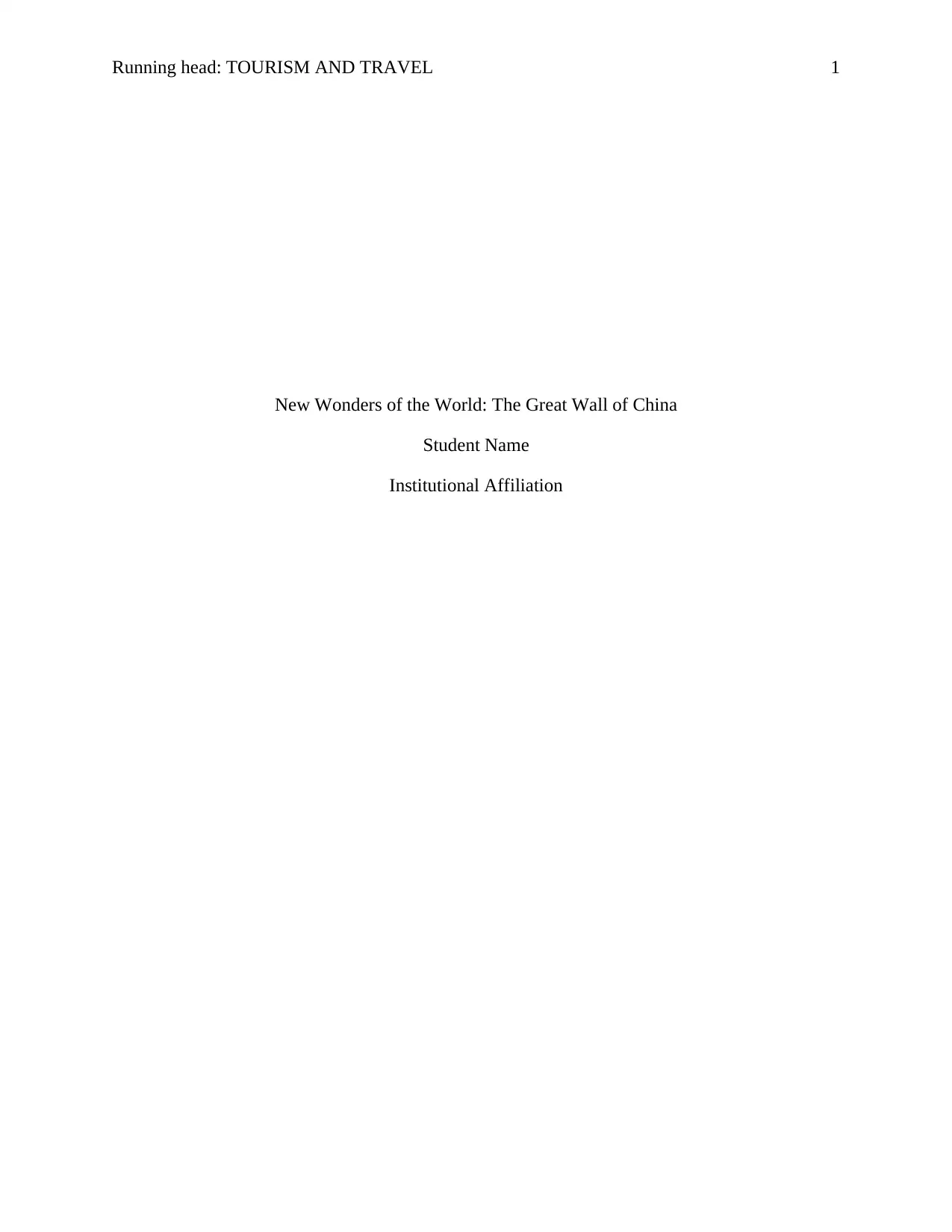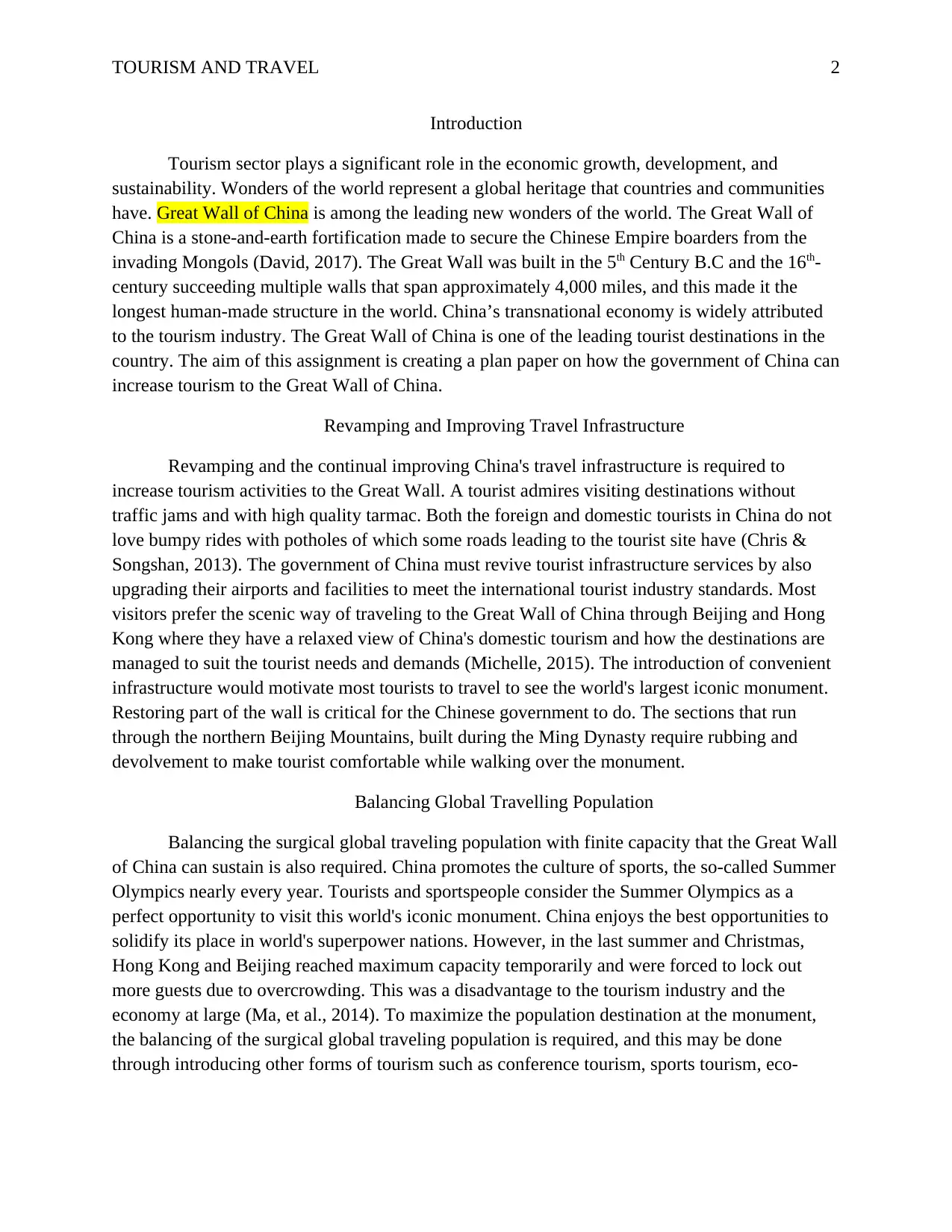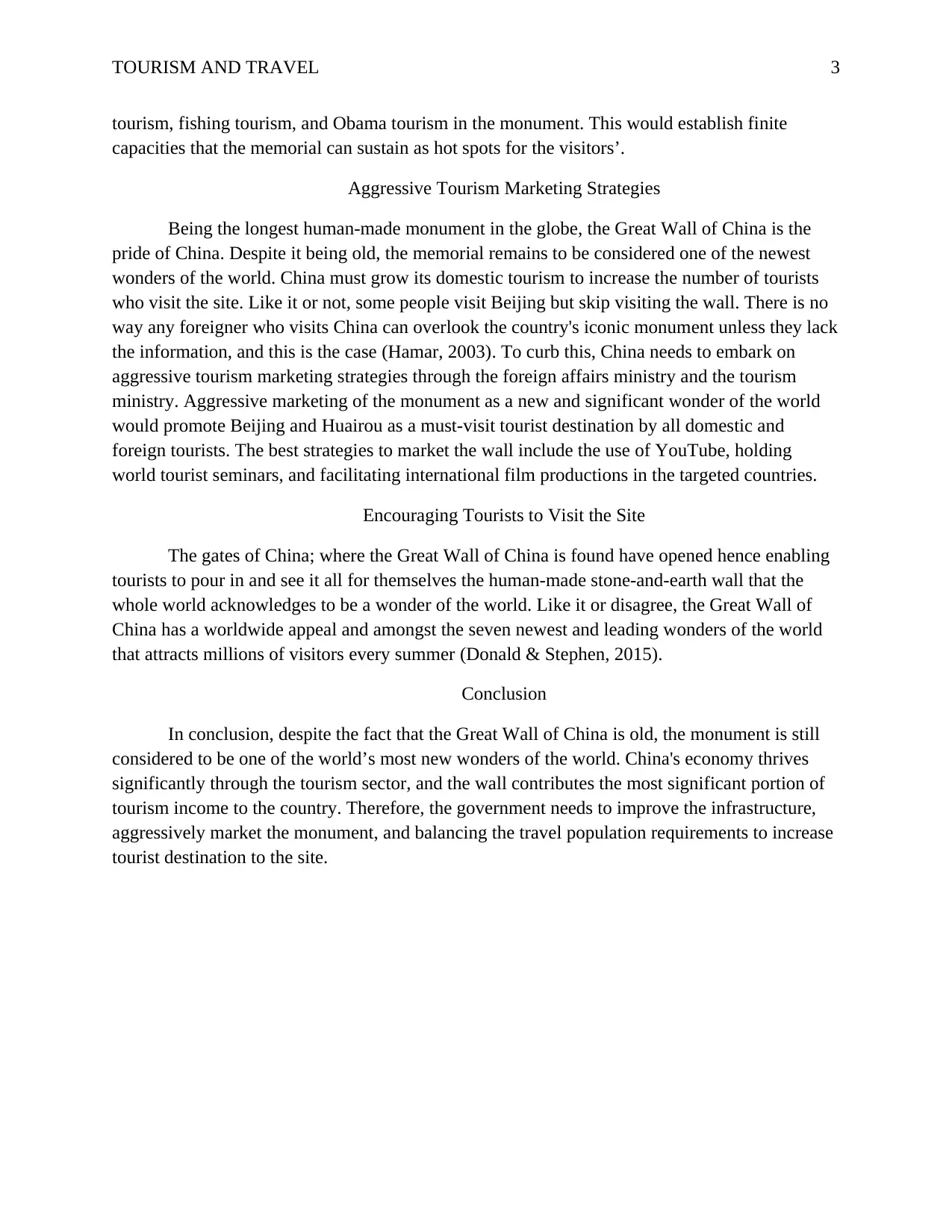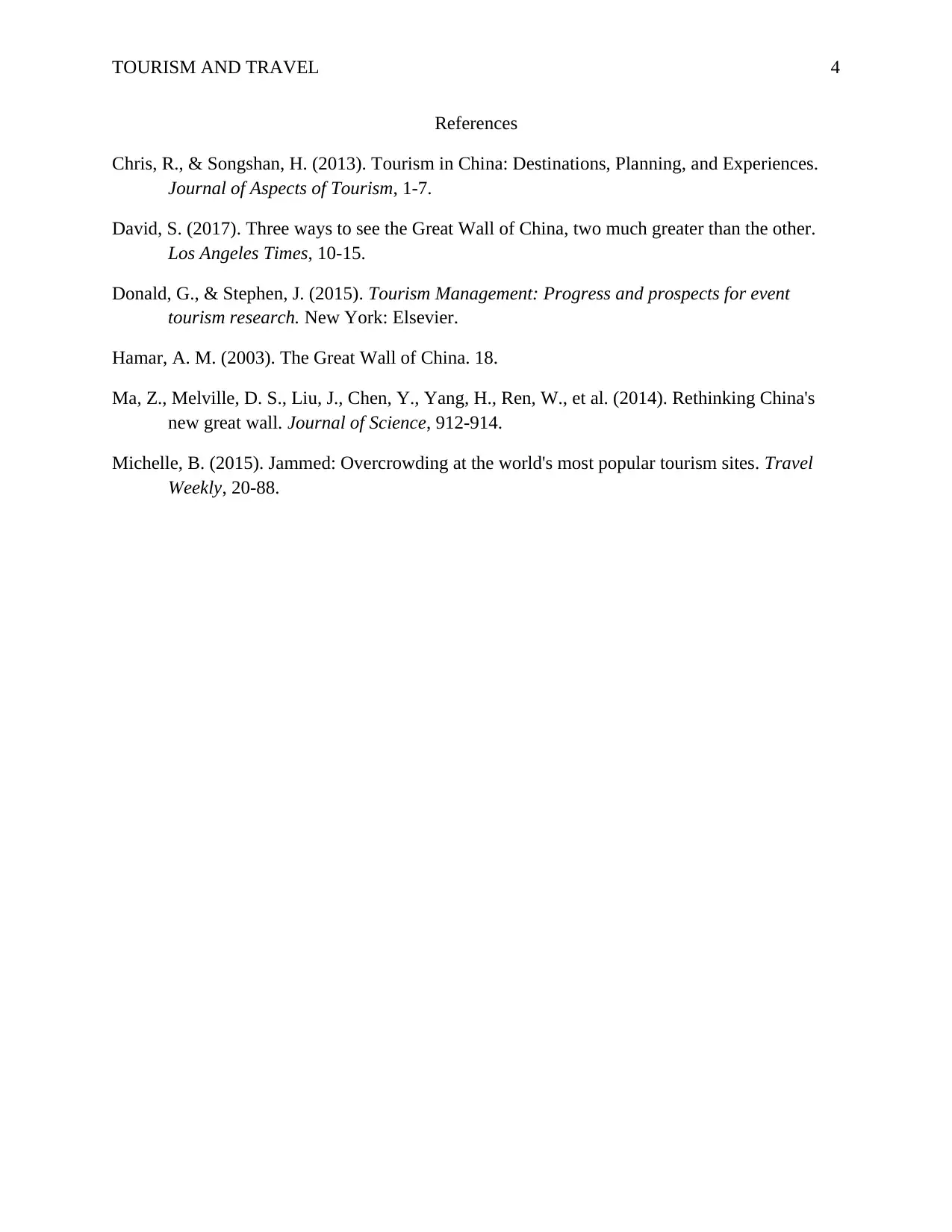Strategies to Boost Tourism at the Great Wall of China - Report
VerifiedAdded on 2020/04/21
|4
|1136
|67
Report
AI Summary
This report focuses on strategies to increase tourism to the Great Wall of China, a significant contributor to China's economic growth. It emphasizes the importance of improving travel infrastructure, including roads and airports, to enhance the tourist experience. The report also addresses the need to balance the global traveling population and suggests implementing various tourism types like conference, sports, and eco-tourism to manage visitor capacity. Furthermore, the report stresses the importance of aggressive marketing strategies, leveraging platforms like YouTube and facilitating international film productions to promote the Great Wall as a must-visit destination. The conclusion reiterates the need for infrastructure upgrades, effective marketing, and population management to maximize tourism to this iconic landmark.

Running head: TOURISM AND TRAVEL 1
New Wonders of the World: The Great Wall of China
Student Name
Institutional Affiliation
New Wonders of the World: The Great Wall of China
Student Name
Institutional Affiliation
Paraphrase This Document
Need a fresh take? Get an instant paraphrase of this document with our AI Paraphraser

TOURISM AND TRAVEL 2
Introduction
Tourism sector plays a significant role in the economic growth, development, and
sustainability. Wonders of the world represent a global heritage that countries and communities
have. Great Wall of China is among the leading new wonders of the world. The Great Wall of
China is a stone-and-earth fortification made to secure the Chinese Empire boarders from the
invading Mongols (David, 2017). The Great Wall was built in the 5th Century B.C and the 16th-
century succeeding multiple walls that span approximately 4,000 miles, and this made it the
longest human-made structure in the world. China’s transnational economy is widely attributed
to the tourism industry. The Great Wall of China is one of the leading tourist destinations in the
country. The aim of this assignment is creating a plan paper on how the government of China can
increase tourism to the Great Wall of China.
Revamping and Improving Travel Infrastructure
Revamping and the continual improving China's travel infrastructure is required to
increase tourism activities to the Great Wall. A tourist admires visiting destinations without
traffic jams and with high quality tarmac. Both the foreign and domestic tourists in China do not
love bumpy rides with potholes of which some roads leading to the tourist site have (Chris &
Songshan, 2013). The government of China must revive tourist infrastructure services by also
upgrading their airports and facilities to meet the international tourist industry standards. Most
visitors prefer the scenic way of traveling to the Great Wall of China through Beijing and Hong
Kong where they have a relaxed view of China's domestic tourism and how the destinations are
managed to suit the tourist needs and demands (Michelle, 2015). The introduction of convenient
infrastructure would motivate most tourists to travel to see the world's largest iconic monument.
Restoring part of the wall is critical for the Chinese government to do. The sections that run
through the northern Beijing Mountains, built during the Ming Dynasty require rubbing and
devolvement to make tourist comfortable while walking over the monument.
Balancing Global Travelling Population
Balancing the surgical global traveling population with finite capacity that the Great Wall
of China can sustain is also required. China promotes the culture of sports, the so-called Summer
Olympics nearly every year. Tourists and sportspeople consider the Summer Olympics as a
perfect opportunity to visit this world's iconic monument. China enjoys the best opportunities to
solidify its place in world's superpower nations. However, in the last summer and Christmas,
Hong Kong and Beijing reached maximum capacity temporarily and were forced to lock out
more guests due to overcrowding. This was a disadvantage to the tourism industry and the
economy at large (Ma, et al., 2014). To maximize the population destination at the monument,
the balancing of the surgical global traveling population is required, and this may be done
through introducing other forms of tourism such as conference tourism, sports tourism, eco-
Introduction
Tourism sector plays a significant role in the economic growth, development, and
sustainability. Wonders of the world represent a global heritage that countries and communities
have. Great Wall of China is among the leading new wonders of the world. The Great Wall of
China is a stone-and-earth fortification made to secure the Chinese Empire boarders from the
invading Mongols (David, 2017). The Great Wall was built in the 5th Century B.C and the 16th-
century succeeding multiple walls that span approximately 4,000 miles, and this made it the
longest human-made structure in the world. China’s transnational economy is widely attributed
to the tourism industry. The Great Wall of China is one of the leading tourist destinations in the
country. The aim of this assignment is creating a plan paper on how the government of China can
increase tourism to the Great Wall of China.
Revamping and Improving Travel Infrastructure
Revamping and the continual improving China's travel infrastructure is required to
increase tourism activities to the Great Wall. A tourist admires visiting destinations without
traffic jams and with high quality tarmac. Both the foreign and domestic tourists in China do not
love bumpy rides with potholes of which some roads leading to the tourist site have (Chris &
Songshan, 2013). The government of China must revive tourist infrastructure services by also
upgrading their airports and facilities to meet the international tourist industry standards. Most
visitors prefer the scenic way of traveling to the Great Wall of China through Beijing and Hong
Kong where they have a relaxed view of China's domestic tourism and how the destinations are
managed to suit the tourist needs and demands (Michelle, 2015). The introduction of convenient
infrastructure would motivate most tourists to travel to see the world's largest iconic monument.
Restoring part of the wall is critical for the Chinese government to do. The sections that run
through the northern Beijing Mountains, built during the Ming Dynasty require rubbing and
devolvement to make tourist comfortable while walking over the monument.
Balancing Global Travelling Population
Balancing the surgical global traveling population with finite capacity that the Great Wall
of China can sustain is also required. China promotes the culture of sports, the so-called Summer
Olympics nearly every year. Tourists and sportspeople consider the Summer Olympics as a
perfect opportunity to visit this world's iconic monument. China enjoys the best opportunities to
solidify its place in world's superpower nations. However, in the last summer and Christmas,
Hong Kong and Beijing reached maximum capacity temporarily and were forced to lock out
more guests due to overcrowding. This was a disadvantage to the tourism industry and the
economy at large (Ma, et al., 2014). To maximize the population destination at the monument,
the balancing of the surgical global traveling population is required, and this may be done
through introducing other forms of tourism such as conference tourism, sports tourism, eco-

TOURISM AND TRAVEL 3
tourism, fishing tourism, and Obama tourism in the monument. This would establish finite
capacities that the memorial can sustain as hot spots for the visitors’.
Aggressive Tourism Marketing Strategies
Being the longest human-made monument in the globe, the Great Wall of China is the
pride of China. Despite it being old, the memorial remains to be considered one of the newest
wonders of the world. China must grow its domestic tourism to increase the number of tourists
who visit the site. Like it or not, some people visit Beijing but skip visiting the wall. There is no
way any foreigner who visits China can overlook the country's iconic monument unless they lack
the information, and this is the case (Hamar, 2003). To curb this, China needs to embark on
aggressive tourism marketing strategies through the foreign affairs ministry and the tourism
ministry. Aggressive marketing of the monument as a new and significant wonder of the world
would promote Beijing and Huairou as a must-visit tourist destination by all domestic and
foreign tourists. The best strategies to market the wall include the use of YouTube, holding
world tourist seminars, and facilitating international film productions in the targeted countries.
Encouraging Tourists to Visit the Site
The gates of China; where the Great Wall of China is found have opened hence enabling
tourists to pour in and see it all for themselves the human-made stone-and-earth wall that the
whole world acknowledges to be a wonder of the world. Like it or disagree, the Great Wall of
China has a worldwide appeal and amongst the seven newest and leading wonders of the world
that attracts millions of visitors every summer (Donald & Stephen, 2015).
Conclusion
In conclusion, despite the fact that the Great Wall of China is old, the monument is still
considered to be one of the world’s most new wonders of the world. China's economy thrives
significantly through the tourism sector, and the wall contributes the most significant portion of
tourism income to the country. Therefore, the government needs to improve the infrastructure,
aggressively market the monument, and balancing the travel population requirements to increase
tourist destination to the site.
tourism, fishing tourism, and Obama tourism in the monument. This would establish finite
capacities that the memorial can sustain as hot spots for the visitors’.
Aggressive Tourism Marketing Strategies
Being the longest human-made monument in the globe, the Great Wall of China is the
pride of China. Despite it being old, the memorial remains to be considered one of the newest
wonders of the world. China must grow its domestic tourism to increase the number of tourists
who visit the site. Like it or not, some people visit Beijing but skip visiting the wall. There is no
way any foreigner who visits China can overlook the country's iconic monument unless they lack
the information, and this is the case (Hamar, 2003). To curb this, China needs to embark on
aggressive tourism marketing strategies through the foreign affairs ministry and the tourism
ministry. Aggressive marketing of the monument as a new and significant wonder of the world
would promote Beijing and Huairou as a must-visit tourist destination by all domestic and
foreign tourists. The best strategies to market the wall include the use of YouTube, holding
world tourist seminars, and facilitating international film productions in the targeted countries.
Encouraging Tourists to Visit the Site
The gates of China; where the Great Wall of China is found have opened hence enabling
tourists to pour in and see it all for themselves the human-made stone-and-earth wall that the
whole world acknowledges to be a wonder of the world. Like it or disagree, the Great Wall of
China has a worldwide appeal and amongst the seven newest and leading wonders of the world
that attracts millions of visitors every summer (Donald & Stephen, 2015).
Conclusion
In conclusion, despite the fact that the Great Wall of China is old, the monument is still
considered to be one of the world’s most new wonders of the world. China's economy thrives
significantly through the tourism sector, and the wall contributes the most significant portion of
tourism income to the country. Therefore, the government needs to improve the infrastructure,
aggressively market the monument, and balancing the travel population requirements to increase
tourist destination to the site.
⊘ This is a preview!⊘
Do you want full access?
Subscribe today to unlock all pages.

Trusted by 1+ million students worldwide

TOURISM AND TRAVEL 4
References
Chris, R., & Songshan, H. (2013). Tourism in China: Destinations, Planning, and Experiences.
Journal of Aspects of Tourism, 1-7.
David, S. (2017). Three ways to see the Great Wall of China, two much greater than the other.
Los Angeles Times, 10-15.
Donald, G., & Stephen, J. (2015). Tourism Management: Progress and prospects for event
tourism research. New York: Elsevier.
Hamar, A. M. (2003). The Great Wall of China. 18.
Ma, Z., Melville, D. S., Liu, J., Chen, Y., Yang, H., Ren, W., et al. (2014). Rethinking China's
new great wall. Journal of Science, 912-914.
Michelle, B. (2015). Jammed: Overcrowding at the world's most popular tourism sites. Travel
Weekly, 20-88.
References
Chris, R., & Songshan, H. (2013). Tourism in China: Destinations, Planning, and Experiences.
Journal of Aspects of Tourism, 1-7.
David, S. (2017). Three ways to see the Great Wall of China, two much greater than the other.
Los Angeles Times, 10-15.
Donald, G., & Stephen, J. (2015). Tourism Management: Progress and prospects for event
tourism research. New York: Elsevier.
Hamar, A. M. (2003). The Great Wall of China. 18.
Ma, Z., Melville, D. S., Liu, J., Chen, Y., Yang, H., Ren, W., et al. (2014). Rethinking China's
new great wall. Journal of Science, 912-914.
Michelle, B. (2015). Jammed: Overcrowding at the world's most popular tourism sites. Travel
Weekly, 20-88.
1 out of 4
Your All-in-One AI-Powered Toolkit for Academic Success.
+13062052269
info@desklib.com
Available 24*7 on WhatsApp / Email
![[object Object]](/_next/static/media/star-bottom.7253800d.svg)
Unlock your academic potential
Copyright © 2020–2025 A2Z Services. All Rights Reserved. Developed and managed by ZUCOL.
